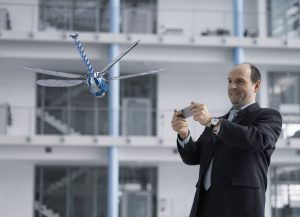 BionicOpter flying robotic insect puts Festo in the record books
BionicOpter flying robotic insect puts Festo in the record books
September 20, 2019 REDWIRE is news you can use from leading suppliers. Powered by FRASERS.
Posted by Festo Inc
Innovate today for a new tomorrow For nearly a hundred years Festo has provided proven Industry Leadership, Super... Read more
Subscribe
Free REDWIRE e-newsletter

This highly integrated system can be operated easily and intuitively via a Smartphone.
Festo has made it into the new edition of Guinness World Records with one of its most exciting innovations: the BionicOpter flying robotic insect. Deemed by Guinness to be the world’s largest flying robot insect, the BionicOpter is an ultra-light machine based on the dragonfly. Like certain other Festo devices, this one is designed with direct inspiration from nature – specifically, from the science of insect flight.
Executes complicated flight manoeuvres
Created by the company’s Bionic Learning Network, the BionicOpter robotic insect follows up on the SmartBird, which Festo developed in 2011 after deciphering bird flight. The developers’ next challenge was to model a robot on the dragonfly at a technical level, and they succeeded beyond their imaginations.
Like its corresponding insect, the BionicOpter can fly in any direction and execute complicated flight manoeuvres. It can move each of its wings independently, which gives it the ability to slow down and turn abruptly, accelerate quickly, or even fly backwards. As a result, the BionicOpter is the first robot model that can emulate all of the flight conditions of helicopters, airplanes, and gliders. But users can operate this highly integrated system easily and intuitively with a Smartphone, regardless of the robot’s complex design.
The Festo team has applied all of the principles of ultra-lightweight construction throughout this flying robotic insect, which weighs a mere 175 grams, has a wingspan of 63 centimetres, and has a body length of 44 centimetres. Each of the wings consists of a carbon-fibre frame and a thin foil covering, and the intelligent kinematics ensure stability by correcting any vibrations during flight. The BionicOpter constantly records data on its position and the twisting of its wings, evaluating them in real time during the flight, to keep itself stable.
Published on Sept. 5, the 2020 edition of Guinness World Records recognizes the BionicOpter as the world’s largest flying robot insect in the chapter “Robots”, which presents top records from the field of super robots and artificial intelligence. Festo is proud of this unique achievement and looks forward to breaking new ground with future innovations.
To learn more, contact Festo.
Share
Posted by Festo Inc
Innovate today for a new tomorrow For nearly a hundred years Festo has provided proven Industry Leadership, Super... Read more
